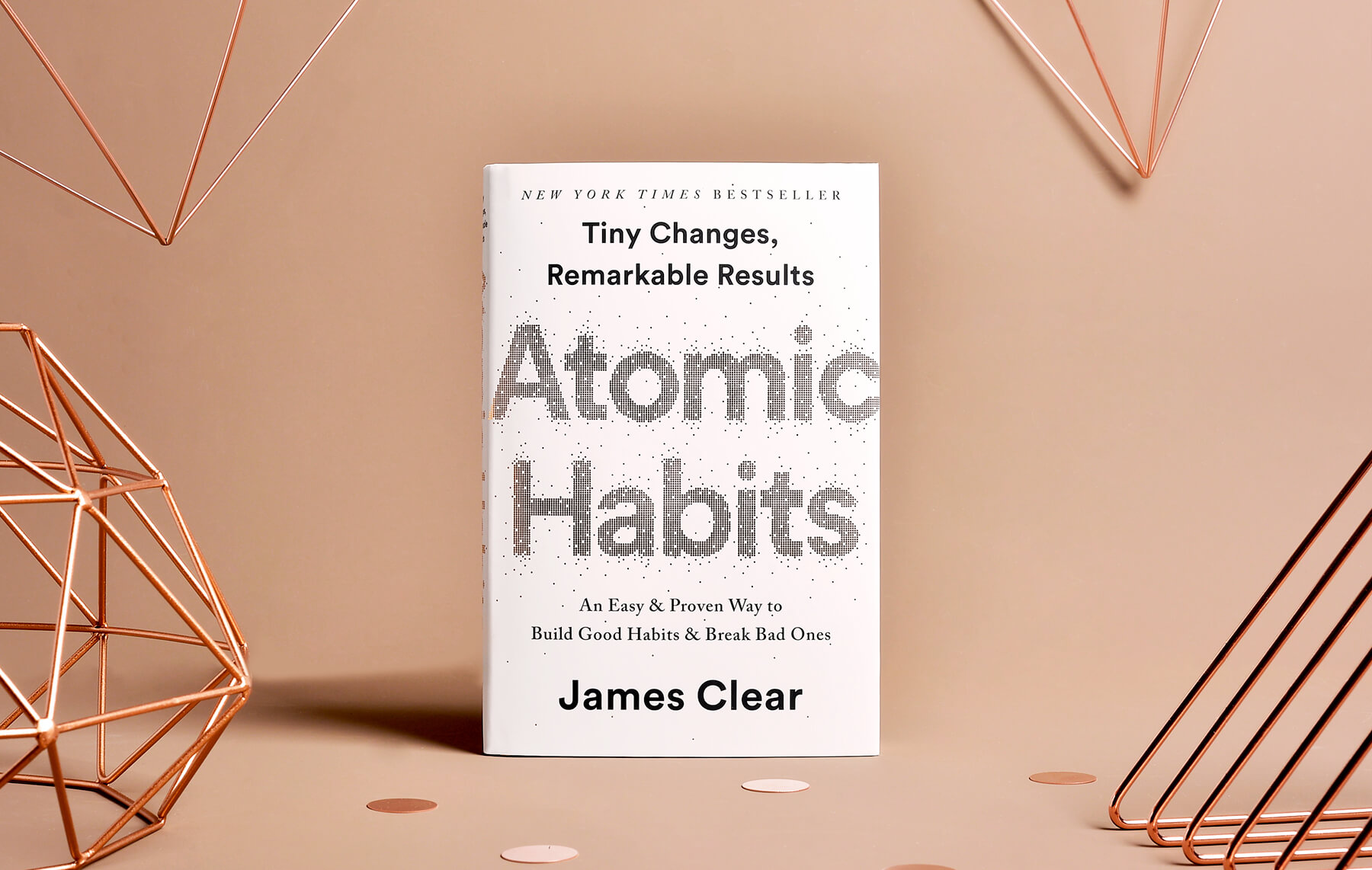Atomic Habits

This book had been in my to-read shelf for quite sometime. I have read the book Power of Habits by Charles Duhigg several years ago. That book was quite an eye opener. It revealed to me how much we are unconsciously controlled by our habits. Atomic Habits by James Clear goes much further with deep insights into how tiny keystone habits can make or break us and actionable plan to implement in our daily life.
Key take awaysPermalink
- We are what we repeatedly do. Who we are is what we do.
- 1 % better everyday in a year => end up 37x better, 1% worse everyday => almost down to zero.
- Align habits with identity than outcome. Decide the type of person who you want to be. Prove it daily with small wins.
- Habits are compound interest of self improvement. The most powerful outcome is always delayed.
- Motivation and self control are scarce and overrated. Environment is the key. Be the designer of our own environment and not merely a consumer of others design.
- Being in motion is not equal to taking action. Actions speak for us. Start with repetition than perfection.
- Don’t break the chain. Put in your reps every day. Don’t just multiply by 0.
Brief summaryPermalink
We are what we repeatedly doPermalink
Seed of every habit is a tiny decision, that grows into a habit when repeated. Be at least 1% better every day. Compounds to 37 times in a year. 1% worse, 33 times down. Small changes seem to make no difference until the critical threshold. Be patient and consistent. Don’t focus on the goals. Focus on the process and systems instead. Continuous improvement and happiness. The most powerful outcome of a compounding process is delayed.
Habits shape our identity. Identity shapes our habitsPermalink
Changing habits is hard because: we change the wrong thing and in wrong way. Identity based habits are more effective than outcome bad habits. It reinforces the behavior in a much stronger way. Be the person who we want to be. (e.g. I want to learn piano versus I want to become a pianist). Who we are is what we do. The more pride we take in particular aspect of our identity, the more motivated we will be to maintain them. When identity and behaviors are aligned, no further changes needed. Be open to continuously edit our beliefs, upgrade and expand identity. Progress requires unlearning. How to change identity for the betterment? - Decide the type of person we want to be. Prove it with small wins every day.
Your outcomes are a lagging measure of your habits. Your net worth is a lagging measure of your financial habits. Your weight is a lagging measure of your eating habits. Your knowledge is a lagging measure of your learning habits. Your clutter is a lagging measure of your cleaning habits. You get what you repeat.
Laws of Behavioral ChangePermalink
Better habits in present allows us to do more of what we want to do in future. Follow Laws of Behavioral Change to build good habits. Follow the inverse to get rid of bad habits.
- Make it obvious
- Make it attractive
- Make it easy
- Make it satisfying
Effective change always begin with awareness and intention. Build awareness with habit scorecard. Build intention with pointing and calling. All these aids in automating the habits we are trying to build.
Make it obviousPermalink
Be aware of when and where to do the action. Make the habit cue obvious. Awareness and intention are the keys. Some tips to build:
- Implementation intention -
I will do <behavior> at <time> in <location>(e.g. I will complete two french lessons at 8am in my office) - Habit stacking -
I’ll do X after Y. After Y, I will do Z(e.g. I will d`o body weight workout after brushing my teeth. After workout, I will meditate for 10 minutes). It strongly reinforces the urge to take action when the cue is noticed.
All big things come from small beginnings. The seed of every habit is a single, tiny decision. But as that decision is repeated, a habit sprouts and grows stronger.
Environment, motivation and self control - visual cues are the best triggers. Be the designer of my own environment and not merely a consumer of others design. Will power and self control are limited resources. If the environment is aligned with the desired habits and identity, we don’t have to change. We can exercise the power of self control elsewhere it matters more. Bad habits are auto catalytic. Make the cues of good habits obvious and bad habits invisible.
Make it attractivePermalink
Habits associated with positive feelings (good habits) versus negative feelings (bad habits). Temptation bundling - tie the things we need to do with the things we want to do. Eventually our needs become attractive and we get more of the them done automatically. By nature, it is our wants that often win over our needs. So tie in big needs with tiny wants to make the needs more attractive. Beware of benefits of avoiding bad habit. Family and friends play a huge role in shaping our habits. We imitate a lot. Join the culture where our desired behavior is the normal behavior (going against the tribe is challenging and makes it difficult to change).
Make it easyPermalink
Does it mean picking easy habits? No. Breakdown the habit we want to master into as small tasks as possible that we find it easy to start with little or no effort (two minute rule). Applies to other big tasks too that we typically procrastinate. Wanna master a new habit? Start with repetition rather than perfection. Law of least effort - prime the environment where it is easy to do the right thing. Reduce the friction with good habits, Increase the fiction with bad habits. Just showing up and putting the reps in reinforces the identity. Consequently builds the habit too.
Make it satisfyingPermalink
First three laws focus on performing a habit one time, this law focuses on sustaining it. Cardinal law of behavioral change - what is immediately rewarded is repeated; what is immediately punished is avoided. In reality, bad habits => immediate rewards, good habits => delayed gratification. Reinforce good habits with small immediate rewards (e.g. healthy juice after daily workout) that are aligned with the identity we are trying to build. Habit tracking with a visual aid - shows progress, provides intrinsic motivation to repeat, acts as its own form of satisfaction, nudged us towards becoming the person we want to. Rule of thumb: Don’t break the chain. Benefits of not breaking the chain on bad days is much higher than following on good days.
FurthermorePermalink
- Pick the right field of competition - Pick the habits that work for our personality. Be self aware. Don’t have to build what others tells to build or the popular ones. Pick the wrong habits, life is then a struggle.
- Goldilocks rule - we experience peak motivation when working on tasks that are just right at the current abilities. Neither too easy(becomes boring) nor too hard(becomes demotivating).
- Downside of good habits - True mastery comes from habits + deliberate practice. Repeat until internalizing a habit/skill, then use that as a foundation for next habit. It easy to become complacent and stuck with a habit once mastered. Break that complacency and with periodic self review and reflection. Life keeps changing us from all directions. Reflection helps to ensure we stay on the right track and correct our course where necessary. The tighter we cling on to an identity, the harder it becomes to find the weak spots and grow outside of it. That makes too brittle when our identity is challenged. Redefine yourself with important aspects of the identity (e.g. I am the CEO ==> I am the type of person who builds and creates great things.)
A lack of self-awareness is poison. Reflection and review is the antidote.
There is so much to learn and internalize that I can’t do it one reading. I have applied and been following some of my learnings (e.g habit stacking, temptation bundling) from this book. I am sure I will find more insights when I read this book again in few months time. Thank you James Clear for this wonderful book.





Comments